The following article “OVERLOADED ~ Deammonification processing can address Canada’s nutrient problem, especially in a severely threatened Lake Winnipeg’ by Simon Baker and Beverley Stinson appeared in the Mar/Apr issue of WaterCanada
 In 2013, Lake Winnipeg was named the world’s “threatened lake of the Year” because of increasing pollution from agricultural run-off and sewage discharges. Excessive nutrients – particularly nitrogen and phosphorus – in Canada’s lakes and rivers
In 2013, Lake Winnipeg was named the world’s “threatened lake of the Year” because of increasing pollution from agricultural run-off and sewage discharges. Excessive nutrients – particularly nitrogen and phosphorus – in Canada’s lakes and rivers are becoming a growing public concern. In response, environment Canada has launched two major government programs worth millions of dollars: the Lake Winnipeg Basin Stewardship Fund and the Great Lakes Nutrient Initiative.
are becoming a growing public concern. In response, environment Canada has launched two major government programs worth millions of dollars: the Lake Winnipeg Basin Stewardship Fund and the Great Lakes Nutrient Initiative.
Lake Winnipeg named worlds most threatened | CTV News.
Research has focused on the specific role of municipal wastewater treatment in contributing to the problem. Analyzing more than 116,000 tonnes of nutrients released from public and private industrial facilities, a study by the federal government’s national pollutant release inventory reported that 85 per cent originated from municipal water and sewage systems.
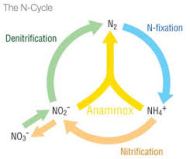 Municipal wastewater treatment can include nitrogen removal processing to help the level of total nitrogen in effluent prior to its discharge. One of the most common methods is nitrification/denitrification. It is a two-step process that involves first converting the wastewater’s ammonia content into nitrates so that it can then be converted into nitrogen gas, a harmless byproduct.
Municipal wastewater treatment can include nitrogen removal processing to help the level of total nitrogen in effluent prior to its discharge. One of the most common methods is nitrification/denitrification. It is a two-step process that involves first converting the wastewater’s ammonia content into nitrates so that it can then be converted into nitrogen gas, a harmless byproduct.
 A typical wastewater treatment plant can reduce total nitrogen levels in effluent down to 5 mg/l in the winter and less than 1 mg/l in the summer using nitrification/denitrification processing,
A typical wastewater treatment plant can reduce total nitrogen levels in effluent down to 5 mg/l in the winter and less than 1 mg/l in the summer using nitrification/denitrification processing,  According to the Canadian Council of Ministers of the Environment. This approach is not, however, without its disadvantages. It involves significant power consumption and, in some cases, the use of costly and hazardous chemicals, predominantly methanol.
According to the Canadian Council of Ministers of the Environment. This approach is not, however, without its disadvantages. It involves significant power consumption and, in some cases, the use of costly and hazardous chemicals, predominantly methanol.
Nitrification/denitrification processing is the conventional option, but if growing public concern over water quality issues leads to new or more stringent nutrient removal requirements for wastewater treatment processing, the associated rise in operating costs will likely be significant.
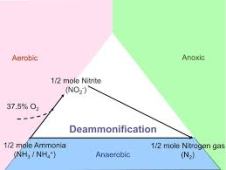 A growing awareness of this problem within North America’s municipal water sector is leading some to consider an emerging solution – to help reduce both the energy
A growing awareness of this problem within North America’s municipal water sector is leading some to consider an emerging solution – to help reduce both the energy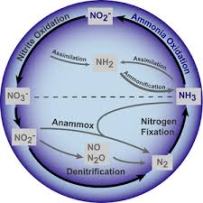 and chemical costs of conventional processing. Deammonification is based on the innovative development of a newmethod using the anaerobic ammonium-oxidizing (anammox) microbial process.
and chemical costs of conventional processing. Deammonification is based on the innovative development of a newmethod using the anaerobic ammonium-oxidizing (anammox) microbial process.
This microbial process involves a previously unknown bacterium, first Discovered in 1995 by scientists at Delft Technical  University in the Netherlands. The bacterium’s unique characteristics provide a completely different metabolic pathway. Nitrogen can be processed under anaerobic conditions, rather than aerobic conditions, thereby reducing energy and chemical costs.
University in the Netherlands. The bacterium’s unique characteristics provide a completely different metabolic pathway. Nitrogen can be processed under anaerobic conditions, rather than aerobic conditions, thereby reducing energy and chemical costs.
The greatest opportunity to reduce energy and chemical costs with deammonification lies in adapting the technology to mainstream treatment configurations. Achieving this goal is the focus of an  international collaborative research effort. The team is led by water agencies in Austria (Achental- Inntal Zillerta Waterboard) and the United States (District of Columbia Water and Sewer Authority and the Hampton Roads Sanitation District, Virginia) and supported by ARa Consult GmbH and AECOM.
international collaborative research effort. The team is led by water agencies in Austria (Achental- Inntal Zillerta Waterboard) and the United States (District of Columbia Water and Sewer Authority and the Hampton Roads Sanitation District, Virginia) and supported by ARa Consult GmbH and AECOM.
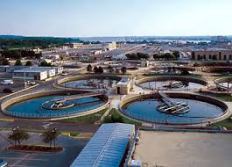 Extensive bench and pilot scale work was undertaken at the Blue Plains wastewater treatment plant in Washington, D.C., and smaller facilities in Virginia to explore viable control strategies for mainstream deammonification with great success.
Extensive bench and pilot scale work was undertaken at the Blue Plains wastewater treatment plant in Washington, D.C., and smaller facilities in Virginia to explore viable control strategies for mainstream deammonification with great success.
The existing nitrification/denitrification configuration at Blue Plains was identified as the plant’s largest energy-consuming process, accounting for 27 per-cent of the total electrical demand. The chemical cost of the methanol required for the processing totals between US$9 million and US$10 million per year. The results from a pilot study and demonstration phase using a mainstream deammonification configuration indicated Blue Plains could obtain a theoretical 65 per cent savings in energy and a 90 per cent savings in chemicals while meeting stringent effluent discharge requirements for nitrogen.
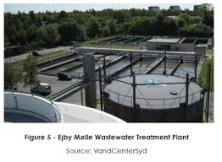 Based on those findings, the team launched a project at the Strass wastewater treatment plant, near Innsbruck, Austria, in 2011, which successfully demonstrated the feasibility of a mainstream deammonification configuration. The plant was able to remove more nitrogen and maintain more stable performance while operating under deammonification than it had achieved while operating in the conventional method during the previous winter.
Based on those findings, the team launched a project at the Strass wastewater treatment plant, near Innsbruck, Austria, in 2011, which successfully demonstrated the feasibility of a mainstream deammonification configuration. The plant was able to remove more nitrogen and maintain more stable performance while operating under deammonification than it had achieved while operating in the conventional method during the previous winter.
While the work in Austria and the United States is helping develop deammonification into a proven solution for mainstream treatment configurations, the first, albeit smaller, steps in Canada are taking place in terms of the technology’s application to sidestream treatment.
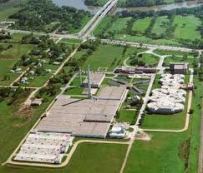 Last year, the City of Winnipeg retained AECOM to prepare an optimization Study for the centrate treatment plant at its North End Water Pollution Control Centre, Winnipeg’s largest wastewater Treatment plant. The study looked at a review of alternative configurations, including sidestream deammonification, to explore options for reducing the energy and chemical costs related to nutrient removal.
Last year, the City of Winnipeg retained AECOM to prepare an optimization Study for the centrate treatment plant at its North End Water Pollution Control Centre, Winnipeg’s largest wastewater Treatment plant. The study looked at a review of alternative configurations, including sidestream deammonification, to explore options for reducing the energy and chemical costs related to nutrient removal.
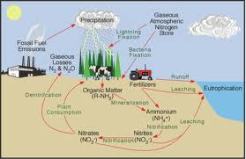 Using the plant’s current nitrification/denitrification configuration as a performance measure, the study suggested deammonification could provide a significant savings in power consumption and methanol, representing an 83 per cent reduction in operating costs when compared to the reference case. Deammonification’s results in lowering these operating costs were also significantly better than those achieved through the other conventional alternatives examined, which ranged from four to 42 per cent.
Using the plant’s current nitrification/denitrification configuration as a performance measure, the study suggested deammonification could provide a significant savings in power consumption and methanol, representing an 83 per cent reduction in operating costs when compared to the reference case. Deammonification’s results in lowering these operating costs were also significantly better than those achieved through the other conventional alternatives examined, which ranged from four to 42 per cent.
 Canada has a strong track record in responding to concerns over water quality issues. After being declared “dead” in the 1960s, Ontario’s Lake Erie became an environmental recovery success story once wastewater treatment plants began to treat effluent by removing phosphorus loads. It is a valuable lesson to remember, but one that comes with an important distinction.
Canada has a strong track record in responding to concerns over water quality issues. After being declared “dead” in the 1960s, Ontario’s Lake Erie became an environmental recovery success story once wastewater treatment plants began to treat effluent by removing phosphorus loads. It is a valuable lesson to remember, but one that comes with an important distinction.
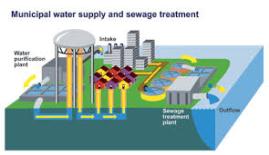 If today’s municipal plants were similarly required to improve their treatment capabilities, they would be doing so in a far different operating environment than their counterparts of more than 50 years ago. Any upgrade investment would need to anticipate the continuing steep rise in associated energy and chemical costs.
If today’s municipal plants were similarly required to improve their treatment capabilities, they would be doing so in a far different operating environment than their counterparts of more than 50 years ago. Any upgrade investment would need to anticipate the continuing steep rise in associated energy and chemical costs.
The potential of deammonification lies in its value of offering a solution to the environmental challenge of reducing nutrient loads, but at the same time allowing operators to manage the inescapable economic realities involved in this challenge.
Simon Baker is a Winnipeg-based, aecom wastewater expert. Beverley Stinson is aecom’s technical lead for biological nutrient removal and director of applied research.

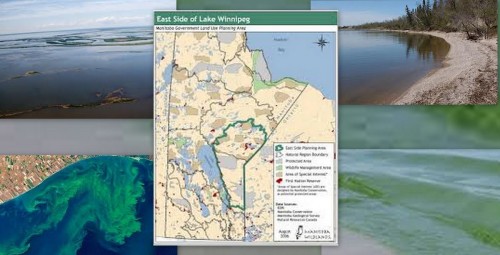
you are in point of fact a excellent webmaster. The web site loading speed
is amazing. It sort of feels that you’re doing any unique trick.
Also, The contents are masterpiece. you’ve done a excellent activity in this topic!
Gracias por sus lindos comentarios sobre este tema. Tenemos una gran variedad de temas para que usted disfrute de su visita de regreso – nos vemos pronto.